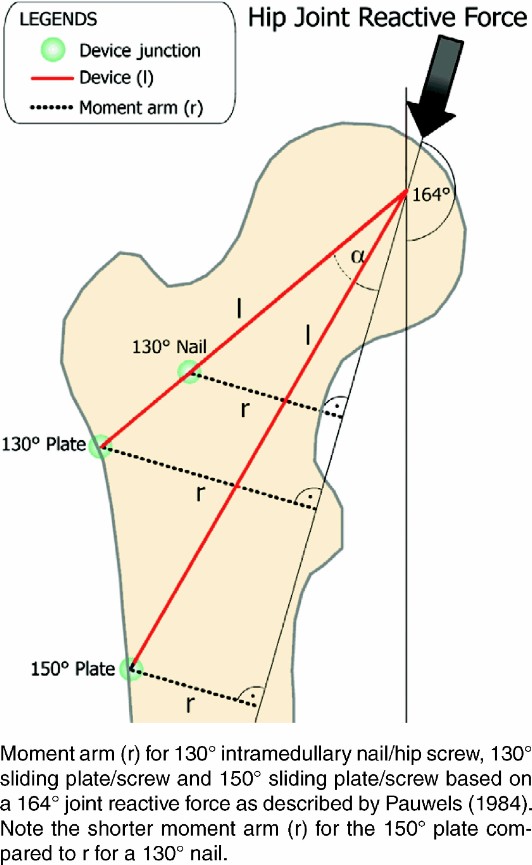Implant options for internal fixation of extracapsu-lar proximal femur fractures include extramedullary and intramedullary devices (plates vs. nails) with different neck-shaft angles, most commonly 130° to 150° for plates and 130° for nails.
The argument in favor of intramedullary devices stems, in part, from the commonly held belief that intramedullary devices offer the theoretical advantage of a shorter moment arm at the plate-screw or nail-screw junction (Koval and Zuckerman Citation2002, Baumgaertner Citation2003, Lorich et al. Citation2004). Koval and Zuckerman (Citation2002) stated that intramedullary devices are subject to smaller bending moments than plate-screw devices because they are positioned closer to the mechanical axis of the femur. Rosenblum et al. (Citation1992) reported that the shorter lever arm of the Gamma nail should reduce the tensile strain on the implant and reduce the risk of failure. Jacobs et al. (Citation1980) found that the shortened lever arm reduces the bending moment and avoids cutout from the femoral head.
The assumptions upon which these statements are based do not seem to take into account the angle of the implants and the direction of the joint reaction force of the hip. There is no consensus on the exact angle of the joint reaction force. Also, it might be different for the individual patient and changes during the gait cycle. However, it is clear that the joint reactive force at the hip is not vertical. Pauwels Citation(1984) reported an angle of 164° to the vertical.
We calculated and compared the bending moments for a 130° intramedullary device, a 130° degree extramedullary device and a 150° extramedullary device using the formula M=|r|*|F|*sinα, where M = bending moment, F = force vector, |r| = magnitude of moment arm vector, r = moment arm vector, |F| = magnitude of force, and α= angle between vector directions.
Using a 164° orientation of the joint reaction force, the bending moment arm of a 150° extramedullary device is reduced by 19% compared to a 130° intramedullary device—based on a lag screw length of 105 mm for the sliding hip screw and approximately 75 mm (medial portion: 55 mm) for the intramedullary hip screw (Figure).

The bending moment is important because it is related to implant failure (breakage) and the displacement at the fracture site. Provided that all other variables are equal (material, dimensions, and geometry of the implant, and type and magnitude of loading), the following statements can be made: 1) The greater the bending moment that the implant is exposed to (“device junction” in the Figure), the more likely it is that the implant will develop fatigue failure, and 2) the greater the bending moment, the greater the displacement at the fracture site under loading.
It cannot be automatically concluded that an intramedullary device is exposed to a lower bending moment than an extramedullary device. Contradictory to current belief, high-angle extramedullary implants may be exposed to a lower bending moment than lower angle intramedullary implants depending on the actual difference in the device angle (e.g. 150° plate vs. 130° nail).
References
- Baumgaertner M R. Intertrochanteric hip fractures. Skeletal trauma, B D Browner, J B Jupiter, A M Levine, P G Trafton, N E Green, M S Swiontkowski. Saunders, Philadelphia 2003; 1797
- Jacobs R R, McClain O, Armstrong H J. Internal fixation of intertrochanteric hip fractures: a clinical and biomechanical study. Clin Orthop 1980, 146: 62–70
- Koval K J, Zuckerman J D Intertrochanteric fractures. Fractures in adults, C A Rockwood, R W Bucholz, J D Heckman, D P Green. Williams & Wilkins, Lippincott 2002; 1644
- Lorich D G, Geller D S, Nielson J H. Osteoporotic pertro-chanteric hip fractures. Management and current controversies. J Bone Joint Surg (Am) 2004; 86(2)398–410
- Pauwels F. Biomechanical principles of varus/valgus inter-trochateric osteotomy (Pauwels I and II) in the treatment of osteoarthritis of the hip. Intertrochanteric osteotomy, J Schatzker. Springer-Verlag, Berlin, Heidelberg, New York, Tokyo. 1984: 4
- Rosenblum S F, Zuckerman J D, Kummer F J, Tam B S. A biomechanical evaluation of the gamma nail. J Bone Joint Surg (Br) 1992; 74(3)352–7